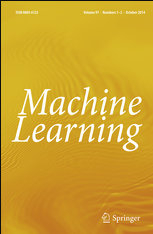Introduction
Introduction
Lower Bound Methods and Separation Results for On-Line Learning Models
Lower bound methods and separation results for on-line learning models
Learning Conjunctions of Horn Clauses
Learning conjunctions of Horn clauses
A learning criterion for stochastic rules
A Learning Criterion for Stochastic Rules
On the Computational Complexity of Approximating Distributions by Probabilistic Automata
On the computational complexity of approximating distributions by probabilistic automata
A Universal Method of Scientific Inquiry
A universal method of scientific inquiry
Machine Learning: A Maturing Field
Machine Learning: A maturing field
Dynamic Parameter Encoding for genetic algorithms
Dynamic Parameter Encoding for Genetic Algorithms
Higher-Order and Modal Logic as a Framework for Explanation-Based Generalization
Higher-order and modal logic as a framework for explanation-based generalization
The Utility of Knowledge in Inductive Learning
The utility of knowledge in inductive learning
Neural network design and the complexity of learning, by J. Stephen Judd. Cambridge, MA: MIT Press, 1990
Book Review:Neural Network Design and the Complexity of Learning, by J. Stephen Judd. Cambridge, MA: MIT Press, 1990
A Reply to Honavar's Book Review of Neural Network Design and the Complexity of Learning
A reply to Honavar's book review of Neural Network Design and the Complexity of Learning
Explorations of an incremental, Bayesian algorithm for categorization
Explorations of an Incremental, Bayesian Algorithm for Categorization
A Bayesian Method for the Induction of Probabilistic Networks from Data
A Bayesian method for the induction of probabilistic networks from data
A framework for average case analysis of conjunctive learning algorithms
A Framework for Average Case Analysis of Conjunctive Learning Algorithms
Learning Boolean Functions in an Infinite Attribute Space
Learning boolean functions in an infinite attribute space
First nearest neighbor classification on Frey and Slate's letter recognition problem
Technical Note: First Nearest Neighbor Classification on Frey and Slate's Letter Recognition Problem

